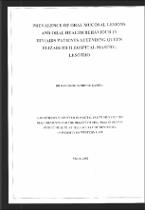| dc.description.abstract | To determine the prevalence of oral mucosal lesions strongly associated with Human Immunodeficiency Virus (HIV) infection and Acquired Immune Deficiency Syndrome (AIDS) according to the European Community-Clearinghouse (ECC) on oral problems related to HIV and the World Health Organisation (WHO) collaborating centre on oral manifestations of the Immunodeficiency Virus (ECC/WHO) classification and assess the oral health behaviour among patients attending Queen Elizabeth II hospital in Maseru. OBJECTIVES: Determine the prevalence of pseudomembranous candidiasis, erythematous candidiasis, linear gingival erythema, angular cheilitis, hairy leukoplakia, Kaposi's sarcoma, acute necrotising gingivitis. acute necrotising periodontitis. non-Hodgkin's lymphoma and oral ulcerations. Assess the oral hygiene practises of the HIV/AIDS patients. Provide baseline data and rnake recornrnendations to all parlies concerned with HIV/AIDS and it's oral manifestations (Oral health departrnent. prirnary health care and the National Aids Prevention and Control Programme). METHODS AND MATERIALS: A sample of 270 patients with a serological diagnosis of HIV inf'ection had a questionnaire administered by an interviewer to assess the oral health behaviour and then examined for oral manifestations. The assessment of oral health behaviour involved assessment of whether the patients cleaned their mouth. the regularity and frequency, use of mouth ,"vash. interdental cleaning aid and other adjunct cleaning aids. The presumptive criteria as defined by the ECC/WHO classification was used for the diagnosis of the oral mucosal lesions. Results were entered and analysed using Epi info-6 statistical software. RESULTS: The prevalence of the specific oral mucosal lesions in order of occurrence was pseudomembranous candidiasis 27Vo. erythematous candidiasis 26oh, angular cheilitis l4oh, hairy leukoplakia l2%. ulcerations l2%. necrotising gingivitis 5%. linear gingivalerythema 304 and non- Hodgkin's lymphoma and Kaposi's sarcoma at less than one percent. This pattern reflects the findings in other regional studies where pseudomembranous candidiasis is often the most common
lesion found. A high rate of cleaning the mouth was recorded with 99oh of the patients cleaning their mouth. 82% of these did it every day. Only about24oh of those cleaning their mouth daily did it twice; the majority (70%) did it once. A low usage of mouthwash and interdental cleaning aid was however noted. CONCLUSIONS: A high prevalence (73%) of oral mucosal lesions was found. This agrees with the findings in many similar regional and international studies. Oral candidiasis was the most common (54%) group of lesions. The oral hygiene practices of the patients were good. | en_US |

